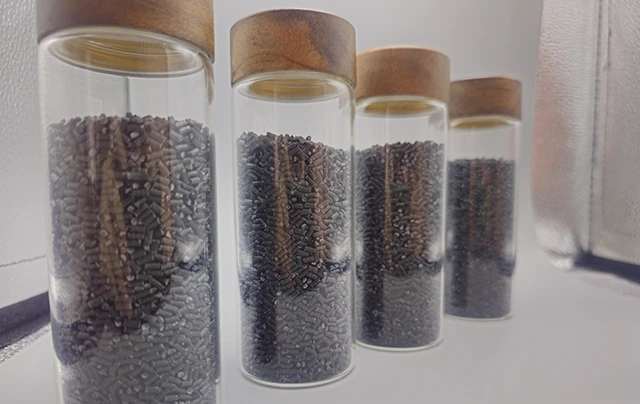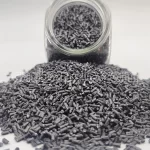
High Quality ABS CF20 Plastic Raw Materials
ABS CF20 represents a significant advancement over traditional ABS plastic by incorporating carbon fiber reinforcement. It offers enhanced mechanical strength, stiffness, and dimensional stability while retaining the inherent benefits of ABS, such as chemical resistance and processability.
- Manufacturer: Carbon New Material
- OEM/ODM: Acceptable
- Color: Black
- Free samples: ≤10kg
- MOQ: 100kg
- Port: Xiamen
- Model No.: ABS-CF-BCA2
What’s ABS CF20?
ABS CF20, or ABS reinforced with 20% carbon fiber, combines the versatile properties of ABS plastic with enhanced mechanical characteristics due to the incorporation of carbon fiber.
This blend results in a material that is well-suited for a variety of demanding applications across different industries.
Features
1. Mechanical Strength:
– ABS CF20% exhibits significantly improved mechanical properties compared to standard ABS. The addition of 20% carbon fiber reinforcement enhances its tensile strength, flexural strength, and impact resistance.
This makes it suitable for applications where structural integrity and durability are crucial.
2. Stiffness and Rigidity:
– The presence of carbon fiber in ABS Cf20% enhances its stiffness and rigidity. This property is beneficial in applications requiring components to withstand mechanical stress without deformation.
It provides better dimensional stability under load compared to traditional ABS.
3. Lightweight:
– Despite its enhanced mechanical properties, ABS 20%CF remains relatively lightweight. This characteristic is advantageous in industries such as automotive and aerospace, where reducing weight can improve fuel efficiency and overall performance.
4. Chemical Resistance:
– ABS Cf20 retains the chemical resistance properties inherent to ABS. It resists a wide range of chemicals, including acids, alkalis, and various industrial chemicals. This makes it suitable for applications exposed to harsh environments or chemical exposure.
5. Thermal Stability:
– Carbon fiber reinforcement in ABS+Cf20 enhances its thermal stability. It exhibits improved resistance to heat distortion and maintains its mechanical properties over a broader temperature range compared to standard ABS. This thermal stability makes it suitable for applications requiring performance under varying temperature conditions.
6. Electrical Properties:
– ABS Cf20% maintains good electrical insulating properties similar to standard ABS. It is capable of withstanding moderate electrical loads and provides reliable insulation in electronic and electrical applications.
7. Surface Finish:
– The addition of carbon fiber in ABS Cf20% can influence the surface finish of molded parts. Depending on the processing method and mold design, it can achieve a smooth surface finish that meets aesthetic and functional requirements.
8. Processability:
– ABS+Cf20 is compatible with various manufacturing processes, including injection molding and extrusion. It can be processed using standard equipment and techniques used for ABS plastics. This facilitates its integration into existing production processes without significant modifications.
9. Design Flexibility:
– The versatility of ABS Cf20 allows for complex part geometries and intricate designs. It can be easily molded into detailed shapes and configurations, providing design flexibility to engineers and designers.
Applications
1. Automotive Industry:
– ABS Cf20 finds extensive use in the automotive sector for manufacturing components such as structural parts, interior trim panels, and under-the-hood applications. Its combination of strength, lightweight nature, and dimensional stability makes it suitable for improving vehicle performance and efficiency.
2. Aerospace and Aviation:
– In aerospace applications, ABS Cf20% is utilized in structural components, cabin interiors, and equipment housings. Its high strength-to-weight ratio and resistance to temperature variations make it suitable for both interior and exterior aerospace applications.
3. Electronics and Electrical Equipment:
– ABS Cf20 is employed in electronic enclosures, connectors, and housings due to its electrical insulating properties and mechanical strength. It provides protection for electronic components while ensuring durability and reliability in demanding environments.
4. Consumer Goods:
– Consumer goods benefit from ABS Cf20% in products requiring durability, such as sporting goods, luggage, and protective gear. Its impact resistance and aesthetic appeal make it suitable for applications where both performance and appearance are essential.
5. Industrial Equipment:
– ABS Cf20% is used in industrial machinery and equipment for components that require robustness and resistance to wear and tear. It withstands mechanical stresses and environmental factors encountered in industrial settings.
6. Medical Devices:
– Medical devices benefit from it in housings and equipment where strength, cleanliness, and durability are critical. Its chemical resistance and biocompatibility (depending on specific formulations) make it suitable for certain medical applications.
7. Construction:
– ABS Cf20 may be used in construction applications where lightweight materials with enhanced mechanical properties are required. It can be found in structural elements, panels, and fittings that need to withstand varying environmental conditions.
If you would like to learn more about ABS carbon fiber reinforced composites or other CFRTPs, please click here.
ABS CF20 Features
ABS CF20 combines ABS plastic with 20% carbon fiber reinforcement, offering improved stiffness, strength, and dimensional stability. It is used in automotive, electronics, and industrial applications requiring high mechanical performance.


Frequently Asked Questions
Carbon (Xiamen) New Material Co., Ltd. aims to provide buyers with "one-stop" worry-free high-quality services. Here you can find all information about carbon fiber engineering plastics. If you still have questions, please send us an email for consultation!
-
How can I contact the manufacturer of a product that interests me?
When you find a product you are interested in, you can contact the manufacturer directly by sending an email and we will get back to you as soon as possible.
-
How do I find the products that interest me?
All you need to do is enter the keyword, product name in the search window and press the Enter key on your keyboard. Your search results page will then be displayed. You can also search within the product category pages on the home page. Each category is divided into subcategories, allowing you to refine your search and find products that interest you.
-
Where will I find a buying guide?
Please contact our after-sales service directly and we will provide you with a comprehensive operating guide.
-
What are CF Reinforced Thermoplastic Composites?
CF Reinforced Thermoplastic Composites are materials where carbon fibers are incorporated into a thermoplastic matrix. They combine the strength and stiffness of carbon fibers with the processability and recyclability of thermoplastics. For instance, they are used in automotive parts like bumper beams.
-
What are the benefits of CF Reinforced Thermoplastic Composites over traditional composites?
The key benefits include faster production cycles, easier recyclability, and better impact resistance. They also offer design flexibility. An example is in the manufacturing of consumer electronics casings where complex shapes can be achieved more easily.
-
How are CF Reinforced Thermoplastic Composites processed?
Common processing methods include injection molding, extrusion, and compression molding. Injection molding is widely used for mass production. For example, in the production of small components for the medical industry.
-
What industries use CF Reinforced Thermoplastic Composites?
They are utilized in aerospace, automotive, medical, and sports equipment industries. In aerospace, they can be found in interior components. In the medical field, they might be used in prosthetics.
-
How does the carbon fiber content affect the properties of the composites?
Higher carbon fiber content generally leads to increased strength and stiffness but may reduce ductility. A moderate content is often balanced for specific applications. For example, a higher content might be preferred in structural parts of a race car.
-
What are the challenges in using CF Reinforced Thermoplastic Composites?
Challenges include higher material costs, complex processing equipment requirements, and ensuring uniform fiber dispersion. Issues with adhesion between the fibers and the matrix can also arise. An example is in achieving consistent quality in large-scale production.

























